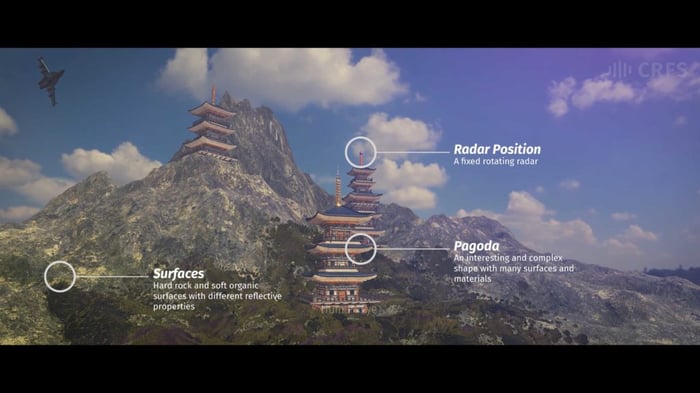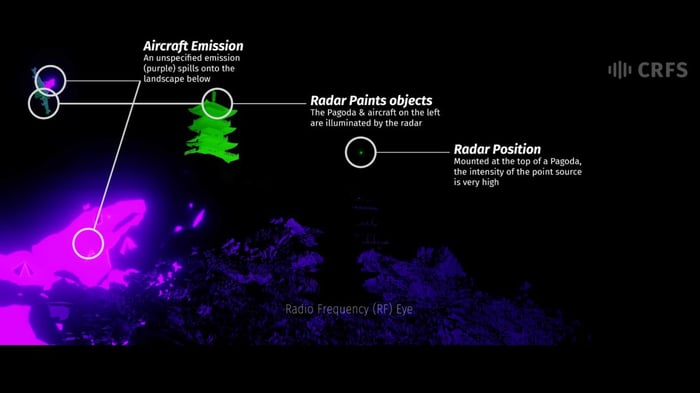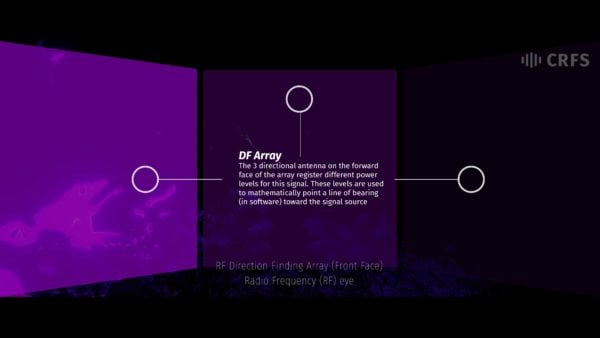
Accurate and reliable DF and geolocation are essential for identifying, tracking, and locating signals of interest. However, RF multipath propagation significantly impacts Direction Finding (DF) and geolocation. This article explains multipath propagation, its effects on DF and geolocation, and strategies to mitigate its adverse impacts.
What is RF multipath propagation?
Multipath propagation occurs when transmitted signals encounter obstacles, leading to multiple reflected, refracted, or diffracted paths. These signals converge at the receiver, creating constructive or destructive interference patterns. Understanding how this phenomenon works is vital for improving the accuracy and reliability of DF and geolocation measurements when gathering intelligence.
The following series of images illustrate how multipath propagation works. Image 1 shows a view as seen by the naked eye.

Image 1: View with the naked eye.
However, imagine being able to see the RF spectrum (without any background noise). Image 2 shows how you would see RF signals emitted from a fighter jet flying above a mountain and ground-based rotating radar located above a pagoda. You would not only see the signals emitted from the transmitters on the jet and the radar; they are also reflected on the mountain (from the jet shown in purple), and on the pagoda (from the radar shown in green).

Image 2: Imagine you could see the RF spectrum.
Now imagine how a DF system, such as an RFeye Array 300, ‘sees’ the RF environment. An RFeye Array 300 has six sides and 360° vision; however, the front three sides (facing the jet and radar in this example) would have the best view of the RF environment.
Image 3 shows how a DF system would see the RF environment. The most visible signals are reflected from the mountain (as multipath caused the original signal from the jet to be sent on several paths to the RF sensor in the DF system). This signal is like an echo, and the direct line-of-site to the source transmitter is damaged.

Image 3: A DF Array’s view of the RF spectrum.
Watch the full "Understanding Multipath RF for Direction Finding", which demonstrates how multiple surface angles, complex objects, jagged rock, and a variety of different natural surfaces reflect radio waves differently from both a moving point of origin and a moving point of view when using the Angle of Arrival (AoA) technique.
The impact of multipath on DF and geolocation in intelligence collection
Multipath propagation can cause significant signal interference, complicating signal interpretation and analysis. While constructive interference can amplify signals, destructive interference can attenuate or nullify them, leading to inaccuracies in locating the source of the signal. Accurate localization is crucial in DF and geolocation operations. However, multipath effects can introduce errors in Time Difference of Arrival (TDoA) and Angle of Arrival (AoA) measurements, resulting in inaccurate positioning and tracking of signal sources.
For systems relying on AoA, multipath can create multiple apparent sources, leading to ambiguity in identifying the signal source. This can result in erroneous geolocation data, complicating operational decision-making. In urban or heavily obstructed environments, multipath propagation is more pronounced, severely reducing the accuracy of DF and geolocation systems. Reflections off buildings, terrain, and other structures create complex signal paths that challenge precise location determination.
Moreover, multipath can also impact the reliability of DF and geolocation systems over time. As environmental conditions change (vehicles move, for example), the path a signal takes can dynamically alter. This variability requires DF systems to adapt, which can strain computational resources and continuously impact real-time processing capabilities.
Additionally, multipath can complicate countermeasure techniques. Jamming and spoofing operations might become more complex since the multipath environment can mask the actual effects of these tactics, leading to unpredictable outcomes. This calls for more advanced strategies to achieve the intended impact.
Lastly, multipath effects can increase the cognitive burden on operators. Interpreting and analyzing data in a multipath-rich environment requires a higher level of expertise and can lead to increased fatigue and potential for error. Providing advanced training and intuitive interfaces can help mitigate these human factors, but they represent an additional challenge in operational settings.
Mitigation strategies for multipath effects
Employing spatial, frequency, and polarization diversity can significantly mitigate the adverse effects of multipath propagation. Utilizing multiple antennas or different frequencies reduces destructive interference and enhances signal quality, resulting in more accurate location estimates. Advanced signal processing techniques, such as adaptive filtering, beamforming, and Maximum Likelihood Estimation (MLE), improve distinguishing between direct and multipath signals. These methods are crucial for refining the accuracy of DF and geolocation systems.
A thorough understanding and modeling of the operational environment can help predict and counteract multipath effects. Adaptive systems that adjust to real-time environmental changes are essential for maintaining operational effectiveness under varying conditions. Deploying high-quality, multipath-resistant hardware, including antennas with superior directional properties and receivers with enhanced sensitivity and dynamic range, can also mitigate the impacts of multipath.
Implementing sophisticated algorithms to filter out multipath components and focus on direct path signals improves accuracy. Techniques like Kalman filtering, particle filtering, and machine learning models greatly enhance geolocation precision. These approaches help distinguish direct signals from reflected ones and optimize the processing of complex signal environments, thereby increasing the overall reliability of DF and Geolocation systems.
In addition to these techniques, cooperative localization can be an effective strategy. By using multiple receivers and combining their data, it is possible to improve the accuracy of geolocation. This cooperative approach leverages the receivers' spatial diversity to mitigate the effects of multipath and provides a more robust solution for signal tracking and location.
Operator training and development are also critical components in mitigating multipath effects. Advanced training programs that recognize and address multipath issues can enhance the operator's ability to interpret and respond to complex signal environments. Providing operators with the skills to use advanced signal processing tools and algorithms can significantly improve the effectiveness of DF and geolocation operations.
Finally, integrating real-time feedback systems can immediately adjust signal processing strategies, ensuring continuous optimization of DF and geolocation accuracy. These feedback systems can dynamically adjust parameters based on current environmental conditions and signal characteristics, providing a proactive approach to managing multipath effects.
By combining these advanced techniques and strategies, it is possible to significantly reduce the impact of multipath propagation on DF and Geolocation systems, ensuring higher accuracy and reliability in intelligence collection operations.
Conclusion
Multipath propagation presents a significant challenge in DF and geolocation operations. However, its effects can be mitigated with a deep understanding and application of advanced techniques. Integrating diversity techniques, advanced signal processing, environmental adaptation, robust hardware, and sophisticated algorithms can enhance the reliability and accuracy of DF and geolocation systems. Continuing to evolve strategies and technologies is essential for maintaining superiority in intelligence collection.
James Spriet from Raven Whispers
James Spriet, Lead EW/ISR SME at Ampex Data Systems and founder of Raven Whispers, leverages his two decades of USAF, SI&T, and Field Engineering experience within the EW/ISR domain to provide thought-provoking insights to the DoD and its supporting industry, enhancing awareness in the field and promoting a culture of ongoing learning and innovation.

